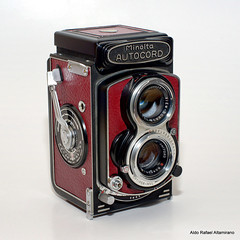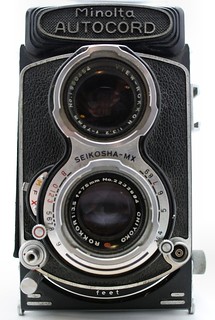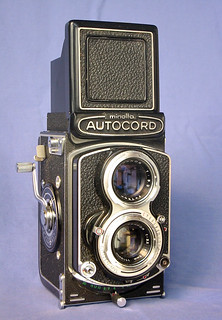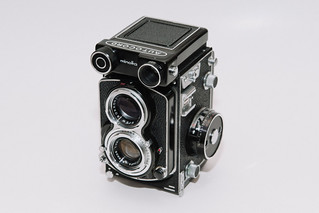Minolta Autocord

|
| Autocord RG I image by Aldo Rafael Altamirano (Image rights) |
Twin-lens reflexes bearing the Minolta name had been offered as early as 1937, starting with the Minoltaflex (I). However, by the mid-1950s, the Japanese TLR market had become quite crowded. The Minolta Autocord series was an effort by Chiyoda Kogaku Seiko, K.K. to compete in the premium-quality segment of the TLR market.
The Autocord series went through a large number of minor variations during its lifespan between 1955 and 1966—at least 17, by one count.[1]
All shared a number of desirable features: crank film advance with automatic shutter cocking and frame counting; a highly regarded Tessar-type 4-element Rokkor f/3.5 lens; self-timer; slow shutter speeds, down to 1 second; and an override button, allowing the advance crank to rotate backwards and cock the shutter without advancing the film, permitting double exposures. Early Optiper shutters only had speeds to 1/400 sec., but this was increased to 1/500 in later versions.
These features compared well with a Tessar-equipped Rolleiflex of the day, yet Autocords sold at a subtantially lower price. Both meterless models and ones including a light meter (originally selenium; later, CdS) were offered in parallel throughout the series.
Many versions of the Autocord feature some form of EV number scale around the taking lens to assist with exposure settings. Some metered models use a quirky system where the shutter and aperture indicators each point to a different row of integers; the photographer was intended to mentally add these two numbers until they equaled the EV indicated on the light meter.[2] A 1957 magazine ad proclaimed, "Your wife or child could have done it—even without looking at the f/stop or shutter speed numbers."[3] Despite this appeal to the male ego, the era's fad for "LVS" settings was brief, and no doubt perplexes Autocord purchasers today who are missing the original manual.
Autocords use a focus lever that protrudes from below the lensboard. Some photographers have noted the ergonomic advantage of this design compared to knob-focusing TLRs such as the Rolleiflex, as it is not necessary to shift the camera between hands for focusing versus winding. But the metal of the Autocord lever is brittle and vulnerable to breakage—the one notable weak link in these otherwise excellent cameras. This focusing mechanism is also found on all postwar Flexarets, beginning in 1945, according to McKeown.
This Minolta Autocord I is a late model among the popular Autocord series of TLR (Twin Lens Reflex) medium-format cameras. It was first introduced in 1965. This meterless camera is equipped with a Citizen-MVL shutter and a Minolta Rokkor 1:3.5 f=75mm taking lens. Autocord II added 220 film compatibility. The counter can can only go up to 12, but can be reset to begin at 1 for exposure 13-24, this can be done with a slider knob on the crank side of the body. The film chamber had a pressure plate for selecting 12 or 24 exp. The Autocord III is similar to previous but adds a 24 exposure counter. Rotate the dial to the correct exposure number. The corresponding meter versions was known as the Minolta Autocord CDS, Autocord CDS II and Autocord CDS III. The name plate has been replaced with the meter reading unit. It has three settings, off, low and high. This can be adjusted by rotating the round lens sensor dial on left hand side. It uses the RM-1R 1.4v mercury battery which is located on the right dial. There is a BC button to check the condition of the battery. On the left hand side of the body, the meter display has ISO selection of 6 to 25,000 ASA.

|

|

|
| Autocord image by Vanessa Lynn (Image rights) |
Autocord I image by Voxphoto (Image rights) |
Autocord CDS image by Aldo Rafael Altamirano (Image rights) |
specs
| Intro | shutter | speed | meter | film | counter | |
|---|---|---|---|---|---|---|
| Autocord MXS | 1955 | Optiper MXS | (old) 1/400 | x | 120 | 12 |
| Autocord MXV | 1955 | Optiper MXV | (old) 1/400 | x | 120 | 12 |
| Autocord L | 1955 | Seikosha Rapid | (old) 1/500 | Selenium | 120 | 12 |
| Autocord LMX | 1958 | Seikosha-MX | (old) 1/500 | Selenium | 120 | 12 |
| Autocord | 1958 | Seikosha-MX | (old) 1/500 | x | 120 | 12 |
| Autocord RG I | 1961 | Optiper MVL | 1/500 | x | 120 | 12 |
| Autocord RG II | 1962 | 1/500 | x | 120 | 12 | |
| Autocord RG III | 1963 | Citizen MVL | 1/500 | x | 120 | 12 |
| Autocord I | 1965 | 1/500 | x | 120 | 12 | |
| Autocord II | 1966 | 1/500 | x | 120 / 220 | 12 | |
| Autocord III | 1966 | 1/500 | x | 24 | ||
| Autocord CDS | 1965 | 1/500 | CdS | 120 | 12 | |
| Autocord CDS II | 1966 | 1/500 | 120 / 220 | 12 | ||
| Autocord CDS III | 1966 | 1/500 | 24 |
Notes
- ↑ Minolta Autocord Twin Lens Reflex by Clayton Rye (archived)
- ↑ The system is described in a Popular Photography launch profile, September, 1956 (Vol. 39, No. 3; pg.128)
- ↑ Popular Photography (USA) Volume 41 No. 1, July 1957. "Minolta Autocord 'L' "(advertisement), pg. 115.
Links
In English:
- Minolta TLRs at TLR Cameras
- Minolta Autocord by Dante Stella
- An early US ad for the Autocord (and Minoltacord), in the August, 1955, Popular Photography magazine; pg. 44.
- Minolta Autocord and Autocord RA in the 70th anniversary Minolta poster, reproduced at Photoclub Alpha
- AutoCord PDF manual at OrphanCameras by Mike Butkus
- AutoCord L PDF manual at OrphanCameras by Mike Butkus
- AutoCord III PDF manual at OrphanCameras by Mike Butkus
- AutoCord CdS PDF manual at OrphanCameras by Mike Butkus
In French:
- Autocord on www.collection-appareils.fr by Sylvain Halgand
In Spanish:
- Minolta Autocord in Paco Medina's Colección de Minoltas
In Japanese:
